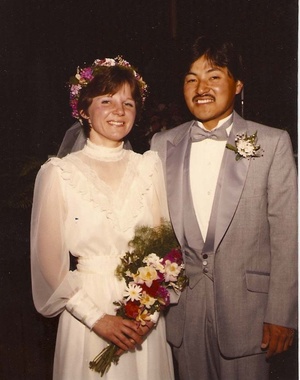My wife and I were married almost 30 years ago. Her family was white, from solid Wisconsin German stock. I was a Japanese American from California. I didn’t think of our marriage as being that much out of the ordinary, but according to a Pew Research Center study, we were part of only 6.7% of new marriages that were interracial in the 1980s.
Flash forward to today. One in seven new marriages is interracial. The rate has more than doubled to 14.6% of new marriages. And more importantly, attitudes are changing.
Just 15 years before I was married, a landmark Supreme Court decision struck down the ban on interracial marriage. In 1967, the Loving versus Virginia case challenged 16 states that still had laws making it illegal to marry outside of one’s race.
Mildred Delores Jeter was a black woman who, in 1958, married Richard Loving, a white man. They didn’t know it was illegal for them to marry in Virginia. This was not just a traffic ticket illegal: They could be arrested with jail time. The soft-spoken couple did not see themselves are heroes of a racial revolution. “We loved each other and got married,” Mildred said. She felt the Supreme Court case was “God’s work.”
I grew up naively believing laws surrounding interracial marriages had been settled long before I was born. Only a few very backward states and regions clung to outdated beliefs and racist attitudes.
I was surprised to learn that during my parents’ generation, anti-miscegenation laws in California were not changed until 1948. After World War II, 38 states still had such laws on their books.
We easily forget the historical context of a seemingly simple act of marriage. In the 1980s, when my wife and I announced our engagement, two-thirds of America had problems with our marriage. According to the Pew study entitled “Marrying Out,” in 1986, 28% felt interracial marriages were not acceptable. Another 37% thought it was acceptable for others but not their own family, an appalling and insidious way of saying interracial marriages were wrong.
After we announced our engagement, I faced surprising attitudes. I heard a few family members express concern over our own marriage. They had claimed not to be racists, so long as it wasn’t their family. Suddenly it was different. One worried about how “those kids” of mixed marriages turned out.
Today, our children can’t imagine anyone in the family once held such opinions—people’s attitudes can change. Yet it’s significant to remember and put things in perspective: Marrying out has evolved from being illegal to taboo to just unusual. Now it’s even less unusual.
I remember the occasional looks, especially from older people who saw interracial couples as a rarity. My parents’ and especially my grandparents’ generation grew up in a world where everyone married people who looked like yourself.
Now, just a few generations later, beliefs have evolved. Instead of two-thirds of Americans against interracial marriages, 63% now say it would be fine if a member of their family were to marry someone from another race or group. And it’s not just attitudes—more than a third have a family member or close relative married to someone of a different race.
But race still matters. A third of America still sees lines drawn based on the color of your skin. And attitudes about different races carry deep seated prejudices.
More are still bothered by a family member marrying an African American versus a Hispanic American or Asian American. I can still recall stories from years ago and families whispering “marry anyone except a black.”
Ironically, today blacks are the most open about marrying outside of their race with more than 70% not seeing a problem, compared with about 60% for Hispanics and Asians. And black men were three times as likely to marry someone of another race, while only 9% of female blacks did the same.
The Pew study also help verify that we in the West lead the nation with 22% of interracial marriages, compared with 11% to 13% in the rest of the nation.
Overall, many have felt interracial marriages are part of the true American experience. Much hope is seen in the children of these couples. Blended kids can become the bridge between two races and represent a small but fast growing demographic group.
If one’s goal is to overcome barriers based on race, the greatest hope may lie with youth. Their attitudes are much more accepting of different races with 80-90% of those between 18-29 supportive of interracial marriages. But I was shocked to learn that among whites over 65, a stubborn majority of 64% still have issues with a relative’s marriage to someone of another race. The phrase “time heals” may stem from the fact that old beliefs aren’t changed, rather they die as people die and their beliefs fade into the past.
Perhaps that’s what occurred in Alabama, the last state to officially change interracial marriage laws. They delayed until 2000 when the state legislature finally overturned their unenforceable ban.
I am thankful for significant changes that have occurred during the decades of my marriage. Beliefs against interracial marriages may linger but many will eventually expire. And I have hope other prejudices will also dissipate as time passes and narrow beliefs dim in the context of history.
*This article was originally published in the Fresno Bee on May 25, 2012.
© 2013 David Mas Masumoto





